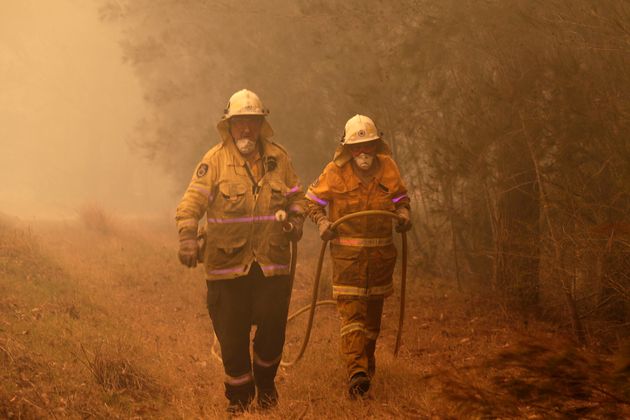Multiple Australian state police agencies have found limited evidence to suggest the major destructive bushfires in their states were ignited by arsonists, contradicting the international onslaught of misinformation suggesting otherwise.
A misleading figure shared by conservative media, apparent bots and trolls, and public figures ―including Donald Trump Jr and veteran Fox News host Sean Hannity ― suggests that 183, or “nearly 200” arsonists have been arrested this bushfire season.
The Australian newspaper first reported 180 alleged arsonists were arrested “since the start of the bushfire season” in September but subsequently updated the story to reflect that these statistics were, in fact, covering the entirety of 2019. Trump Jr and Hannity, among others, spread the initial inaccurate statistic.
Though a handful of fires have been ignited by arsonists, authorities including the Victorian fire chief have confirmed that the majority of the largest blazes were ignited by dry lightning, not arson.
Dale Dominey-Howes, a professor of hazard and disaster risk sciences at the University of Sydney, told HuffPost there was a link between climate change and both the ignition and exacerbation of the bushfires.
“The majority of these bushfires have been generated by lightning strikes associated with weather and climate effects. Weather and climate are dominated by processes that are affected by climate change. So there is a link between climate change and the triggering or the starting of these fires,” Dominey-Howes said.
And even when a fire is ignited by human activity, climate still plays a major role in how much fuel is available for the fire and the conditions that worsen the blazes.
“And then they’ve been much worse because we’re in a particularly bad period of drought,” said Dominey-Howes. “Very dry, hot weather, all of which are the conditions that favor the spread of bushfires.”

Police in the states most affected by the fires ― New South Wales, Victoria and South Australia ― provided HuffPost with clarification on the misleading statistics that are making the rounds.
A South Australia police spokesperson said there is “nothing to immediately suggest that the significant recent fires in the Adelaide Hills and Kangaroo Island were deliberately lit.” Since September 2019, 10 people in the state have been arrested for intentionally or recklessly causing a bushfire.
In the state of Victoria, police confirmed in a statement that “there is currently no intelligence to indicate that the fires in East Gippsland and the North East regions have been caused by arson or any other suspicious behaviour.” One blaze, which started Saturday morning but was contained by that evening, is being treated as suspicious. Victoria Police have not yet released data on crime statistics from September to December 2019 and were unable to provide the number of arson-related arrests.
In the hardest-hit state of New South Wales, police released a statement saying that 183 people had been charged with “bushfire-related offences since late last year.” Of this number, only 24 people were charged with deliberately lighting a bushfire. Other offenses listed included failing to comply with a total fire ban or discarding a lighted cigarette on land ― offenses that may not necessarily result in a fire.
NSW Police clarified in a statement to HuffPost: “The breach of the total fire ban or discarding of a lit cigarette is not an arson offense as these actions may not result in a fire. A breach of the total fire ban may be as simple as having an open flamed BBQ in your backyard.”
Queensland Police provided a statement saying that of 1,068 reported bushfires, 114 were ignited through human involvement subject to police enforcement. Queensland ― which unlike other states has had a relatively normal fire season ― saw 109 people dealt with by police for offenses that included unauthorised lighting of fires. However, this figure included people who violated local fire bans and endangered property.
Though arson certainly does play a role in the fires, the misleading numbers first reported highly exaggerate its contribution, and the misinformation spread rapidly in Australia and the US.
Timothy Graham, a senior lecturer on social network analysis at the Queensland University of Technology, conducted preliminary research that found what he believes to be an orchestrated “disinformation campaign” led by bot-like and troll-like accounts spreading the hashtag #ArsonEmergency in an attempt to shift blame for the wildfires away from climate change.
Many accounts using this hashtag also latched on to the misleading “nearly 200” figure.
“The conspiracy theories going around (including arson as the main cause of the fires) reflect an increased distrust in scientific expertise, skepticism of the media, and rejection of liberal democratic authority,” Graham told The Guardian.
Other misinformation about the fires includes theories about “greenies” preventing hazard reduction burns that led to a build-up of fuel for bushfires, a claim pushed by Barnaby Joyce, a former federal leader of the Nationals Party, and was splashed across social media.
Shane Fitzsimmons, commissioner of the NSW Rural Fire Service, bluntly addressed these claims on an Australian Broadcasting Corp account, saying that longer and hotter fire seasons ― contributed to by climate change ― left a shrinking window of opportunity to complete these prophylactic burns. The Greens party issued a statement clarifying that they, in fact, support hazard reduction burns.